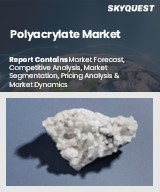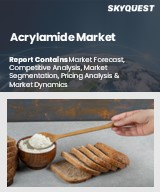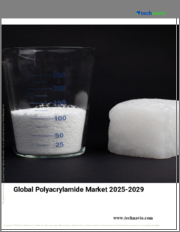
|
시장보고서
상품코드
1661124
세계의 아크릴아미드 모노머 시장 보고서 : 최종 용도별, 지역별(2025-2033년)Acrylamide Monomer Market Report by End-Use (Waste and Wastewater Treatment, Petroleum (Mostly Drilling Fluid), Pulp/Paper, Mining, Coating, Printing/Dying, and Others), and Region 2025-2033 |
||||||
아크릴아미드 모노머 시장 세계 시장 규모는 2024년 51억 달러에 달했습니다. 향후 IMARC Group은 2033년까지 시장 규모가 102억 달러에 달할 것으로 예상하며, 2025-2033년간 8%의 연평균 성장률(CAGR)을 나타낼 것으로 전망하고 있습니다. 이 시장은 수처리 공정에서의 제품 사용 증가, 석유 및 가스 부문의 괄목할 만한 성장, 펄프 및 제지 산업의 최근 기술 혁신, 세계 각국의 엄격한 환경 규제 부과, 농업 부문의 급속한 확장 등을 배경으로 급성장하고 있습니다.
아크릴아미드 모노머(또는 아크릴아미드)는 아크릴로니트릴의 수화에 의해 생성되는 무색, 무취의 화합물입니다. 물, 알코올, 아세톤에는 용해되지만 벤젠과 헵탄에는 용해되지 않습니다. 상온에서는 안정적이지만 융점이나 자외선 아래에서 격렬하게 중합될 수 있습니다. 세계 아크릴아미드 모노머 시장은 현재 다양한 산업에서의 응용에 의해 주도되고 있습니다. 이 시장의 성장을 이끄는 주요 요인 중 하나는 폴리아크릴아미드의 합성에 아크릴아미드 모노머가 사용되며, 폐수 처리에도 사용되고 있습니다. 산업 및 지자체 공장에 대한 폐기물 제한을 요구하는 환경 규제가 증가함에 따라 선진 산업 국가들은 현재 폐수 처리에 폴리 아크릴아미드를 사용하는 방향으로 나아가고 있습니다. 본 보고서에서는 지역별 시장 분석, 최종 용도별 시장 분석, 밸류체인 분석, 수출입 동향, 주요 기업, 시장 전망 등 폴리아크릴아미드 산업에 대한 종합적인 정보를 제공합니다. 또한, 아크릴아미드 모노머의 제조 공정에 대해서도 제조업체의 주요 성공 요인과 위험 요인, 제조 공정의 흐름, 관련 반응, 원료와 그 요구사항 등에 대해 설명합니다.
본 보고서에서 다룬 주요 질문
- 2024년 세계 아크릴아미드 모노머 시장 규모는?
- 예측 기간(2025-2033년) 동안 세계 아크릴아미드 모노머 시장 전망은?
- 코로나19가 세계 아크릴아미드 모노머 시장에 미치는 영향은?
- 세계 아크릴아미드 모노머 시장을 주도하는 요인은 무엇인가?
- 세계 아크릴아미드 모노머 시장의 주요 동향은?
- 세계 아크릴아미드 모노머 시장의 최종 용도별 시장 현황은?
- 세계 아크릴아미드 모노머 시장의 주요 지역은?
- 세계 아크릴아미드 모노머 시장의 주요 기업은?
목차
제1장 서문
제2장 조사 범위와 조사 방법
- 조사 목적
- 이해관계자
- 데이터 소스
- 1차 정보
- 2차 정보
- 시장 추정
- 보텀업 접근
- 톱다운 접근
- 조사 방법
제3장 주요 요약
제4장 서론
- 개요
- 프롭퍼티
- 주요 업계 동향
제5장 세계의 아크릴아미드 모노머 산업
- 시장 개요
- 시장 실적
- 수량 동향
- 매출 동향
- COVID-19의 영향
- 가격 분석
- 주요 가격 지표
- 가격 구조
- 가격 동향
- 시장 분석 : 지역별
- 시장 분석 : 최종 용도별
- 시장 예측
- SWOT 분석
- 개요
- 강점
- 약점
- 기회
- 위협
- 밸류체인 분석
- 개요
- 연구개발
- 원재료 조달
- 제조
- 마케팅
- 유통
- 최종 용도
- Porter의 Five Forces 분석
- 개요
- 바이어의 교섭력
- 공급 기업의 교섭력
- 경쟁 정도
- 신규 진출업체의 위협
- 대체품의 위협
- 무역 데이터
- 수입
- 수출
- 시장 성장 촉진요인과 성공 요인
제6장 주요 지역 실적
- 아시아
- 시장 동향
- 시장 예측
- 미국
- 시장 동향
- 시장 예측
- 유럽
- 시장 동향
- 시장 예측
- 중동 및 아프리카
- 시장 동향
- 시장 예측
- 기타
- 시장 동향
- 시장 예측
제7장 시장 분석 : 최종 용도별
- 폐기물 및 폐수 처리
- 시장 동향
- 시장 예측
- 석유(주로 시추액)
- 시장 동향
- 시장 예측
- 펄프/종이
- 시장 동향
- 시장 예측
- 광업
- 시장 동향
- 시장 예측
- 코팅
- 시장 동향
- 시장 예측
- 인쇄/염색
- 시장 동향
- 시장 예측
- 기타
- 시장 동향
- 시장 예측
제8장 경쟁 구도
- 시장 구조
- 주요 기업의 생산능력
- 주요 기업 개요
제9장 아크릴아미드 모노머 제조 공정
- 제품 개요
- 관여하는 화학반응
- 제조 공정
- 세부 프로세스 플로우
- 원재료 요건
- 물질 수지와 원료 전환율
제10장 아크릴아미드 모노머 원료 시장 분석
- 아크릴로니트릴
- 시장 실적
- 수량 동향
- 매출 동향
- 가격 동향
- 시장 분석 : 지역별
- 시장 분석 : 최종 용도별
- 주요 공급업체
- 시장 실적
The global acrylamide monomer market size reached USD 5.1 Billion in 2024. Looking forward, IMARC Group expects the market to reach USD 10.2 Billion by 2033, exhibiting a growth rate (CAGR) of 8% during 2025-2033. The market is growing rapidly driven by the increasing product utilization in water treatment process, significant growth in the oil and gas sector, recent innovation in the pulp and paper industry, imposition of stringent environmental regulations across the globe, and the rapid expansion of the agriculture sector.
Acrylamide monomer (or acrylic amide) is a colourless and odourless chemical compound formed by the hydration of acrylonitrile. It is soluble in water, alcohol and acetone but immiscible in benzene and heptanes. Although it is stable at room temperature, it can violently polymerize at its melting point or under UV light. The global acrylamide monomer market is currently being driven by its uses in diverse industries. One of the major factors boosting the growth of this market is the use of acrylamide monomer in the synthesis of polyacrylamide which is further used in wastewater treatment. Due to increasing environmental regulations which demand the industrial and municipal plants to limit their waste, the industrialised countries are now turning towards the use of polyacrylamide in their wastewater treatment. The report provides a comprehensive insight into the industry including its market break-up by region, market breakup by end-uses, value chain analysis, import and export trends, key players and market outlook. The report also gives an in-sight into the manufacturing process of acrylamide monomer covering key success and risk factors for manufacturers, manufacturing process flow, the reactions involved, raw materials and their requirements, etc.
Key Market Segmentation:
Breakup by End-Use:
- Waste and Wastewater Treatment
- Petroleum (Mostly Drilling Fluid)
- Pulp/Paper
- Mining
- Coating
- Printing/Dying
- Others
The report has segmented the global acrylamide monomer market on the basis of its end-uses. Acrylamide monomer finds wide ranging applications encompassing a number of industries such as waste and wastewater treatment, petroleum (mostly drilling fluid), pulp/paper, mining, coating and printing/dying. Waste and wastewater treatment currently represents the dominating segment for this market. Other uses of acrylamide monomer include as a comonomer in superabsorbent polymers, cosmetic and personal care, production of n-methylolacrylamide, irrigation purposes in agriculture and food applications.
Breakup by Region:
- Asia
- United States
- Europe
- Middle East and Africa
- Others
The report has also segmented the global acrylamide monomer market according to its key regions and finds that Asia represents its biggest producer accounting for the majority of the total global production. Based on the analysis of the global import and export data, the report finds that the Unites States is the largest importer of acrylamide monomer. China represents the largest exporter of acrylamide monomer.
Competitive Landscape:
The report has also analysed the key players operating in the global acrylamide monomer market. SNF Group represents the world's largest acrylamide monomer manufacturer. SNF Group is followed by China National Petroleum Corporation, Kemira, Beijing Hengju Oilfield, BASF and Dia-Nitrix.
Key Questions Answered in This Report
- 1.What was the global acrylamide monomer market size in 2024?
- 2.What will be the global acrylamide monomer market outlook during the forecast period (2025-2033)?
- 3.What is the impact of COVID-19 on the global acrylamide monomer market?
- 4.What are the global acrylamide monomer market drivers?
- 5.What are the major trends in the global acrylamide monomer market?
- 6.What is the global acrylamide monomer market breakup by end use?
- 7.What are the major regions in the global acrylamide monomer market?
- 8.Who are the leading acrylamide monomer market players?
Table of Contents
1 Preface
2 Scope and Methodology
- 2.1 Objectives of the Study
- 2.2 Stakeholders
- 2.3 Data Sources
- 2.3.1 Primary Sources
- 2.3.2 Secondary Sources
- 2.4 Market Estimation
- 2.4.1 Bottom-Up Approach
- 2.4.2 Top-Down Approach
- 2.5 Forecasting Methodology
3 Executive Summary
4 Introduction
- 4.1 Overview
- 4.2 Properties
- 4.3 Key Industry Trends
5 Global Acrylamide Monomer Industry
- 5.1 Market Overview
- 5.2 Market Performance
- 5.2.1 Volume Trends
- 5.2.2 Value Trends
- 5.3 Impact of COVID-19
- 5.4 Price Analysis
- 5.4.1 Key Price Indicators
- 5.4.2 Price Structure
- 5.4.3 Price Trends
- 5.5 Market Breakup by Region
- 5.6 Market Breakup by End Use
- 5.7 Market Forecast
- 5.8 SWOT Analysis
- 5.8.1 Overview
- 5.8.2 Strengths
- 5.8.3 Weaknesses
- 5.8.4 Opportunities
- 5.8.5 Threats
- 5.9 Value Chain Analysis
- 5.9.1 Overview
- 5.9.2 Research and Development
- 5.9.3 Raw Material Procurement
- 5.9.4 Manufacturing
- 5.9.5 Marketing
- 5.9.6 Distribution
- 5.9.7 End-Use
- 5.10 Porter's Five Forces Analysis
- 5.10.1 Overview
- 5.10.2 Bargaining Power of Buyers
- 5.10.3 Bargaining Power of Suppliers
- 5.10.4 Degree of Competition
- 5.10.5 Threat of New Entrants
- 5.10.6 Threat of Substitutes
- 5.11 Trade Data
- 5.11.1 Imports
- 5.11.2 Exports
- 5.12 Key Market Drivers and Success Factors
6 Performance of Key Regions
- 6.1 Asia
- 6.1.1 Market Trends
- 6.1.2 Market Forecast
- 6.2 United States
- 6.2.1 Market Trends
- 6.2.2 Market Forecast
- 6.3 Europe
- 6.3.1 Market Trends
- 6.3.2 Market Forecast
- 6.4 Middle East and Africa
- 6.4.1 Market Trends
- 6.4.2 Market Forecast
- 6.5 Others
- 6.5.1 Market Trends
- 6.5.2 Market Forecast
7 Market Breakup by End Use
- 7.1 Waste and Wastewater Treatment
- 7.1.1 Market Trends
- 7.1.2 Market Forecast
- 7.2 Petroleum (Mostly Drilling Fluid)
- 7.2.1 Market Trends
- 7.2.2 Market Forecast
- 7.3 Pulp/Paper
- 7.3.1 Market Trends
- 7.3.2 Market Forecast
- 7.4 Mining
- 7.4.1 Market Trends
- 7.4.2 Market Forecast
- 7.5 Coating
- 7.5.1 Market Trends
- 7.5.2 Market Forecast
- 7.6 Printing/Dying
- 7.6.1 Market Trends
- 7.6.2 Market Forecast
- 7.7 Others
- 7.7.1 Market Trends
- 7.7.2 Market Forecast
8 Competitive Landscape
- 8.1 Market Structure
- 8.2 Production Capacities of Key Players
- 8.3 Key Player Profiles
9 Acrylamide Monomer Manufacturing Process
- 9.1 Product Overview
- 9.2 Chemical Reactions Involved
- 9.3 Manufacturing Process
- 9.4 Detailed Process Flow
- 9.5 Raw Material Requirement
- 9.6 Mass Balance and Feedstock Conversion Rates
10 Acrylamide Monomer Feedstock Market Analysis
- 10.1 Acrylonitrile
- 10.1.1 Market Performance
- 10.1.1.1 Volume Trends
- 10.1.1.2 Value Trends
- 10.1.2 Price Trends
- 10.1.3 Market Breakup by Region
- 10.1.4 Market Breakup by End-Use
- 10.1.5 Key Suppliers
- 10.1.1 Market Performance



















